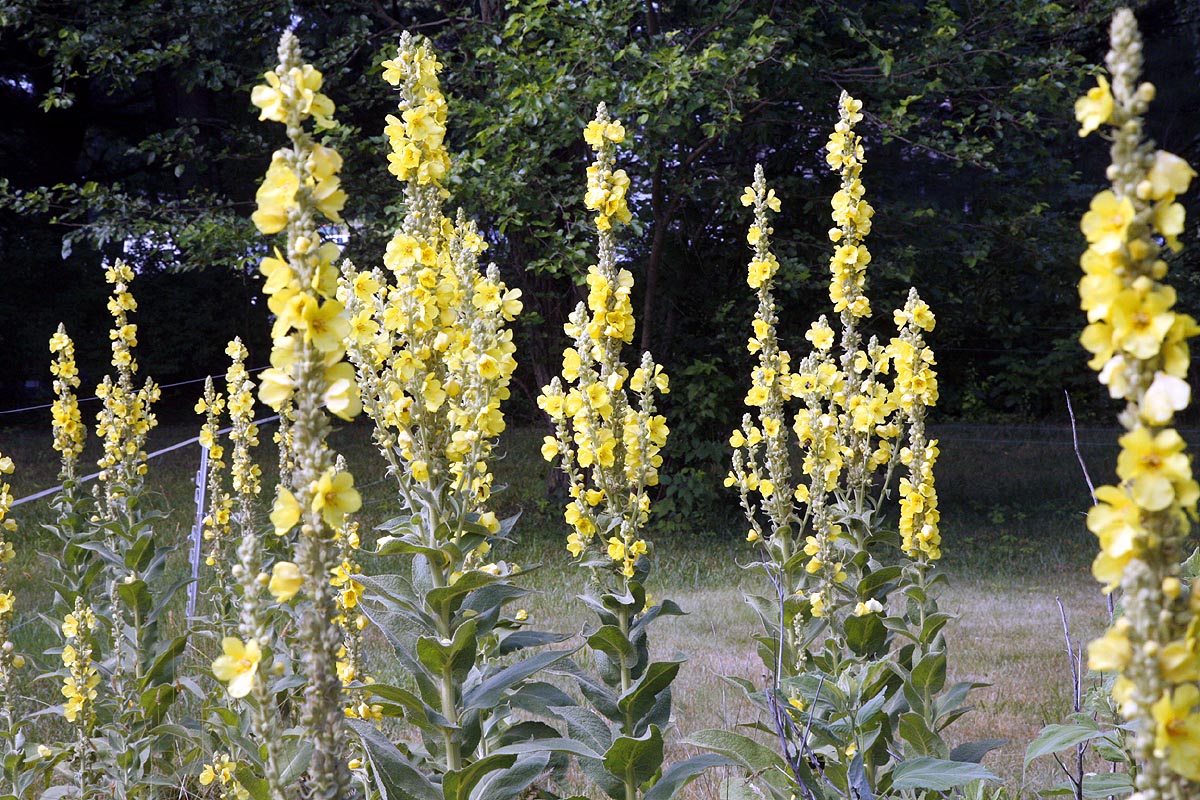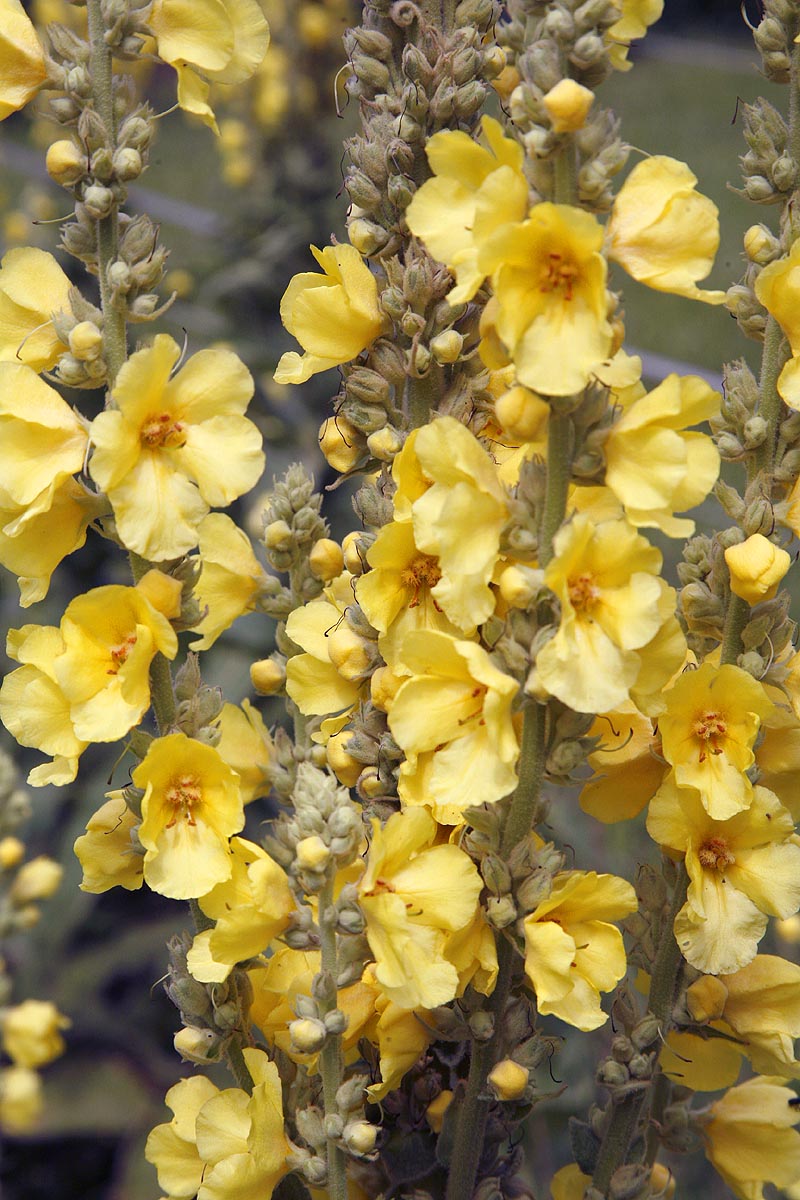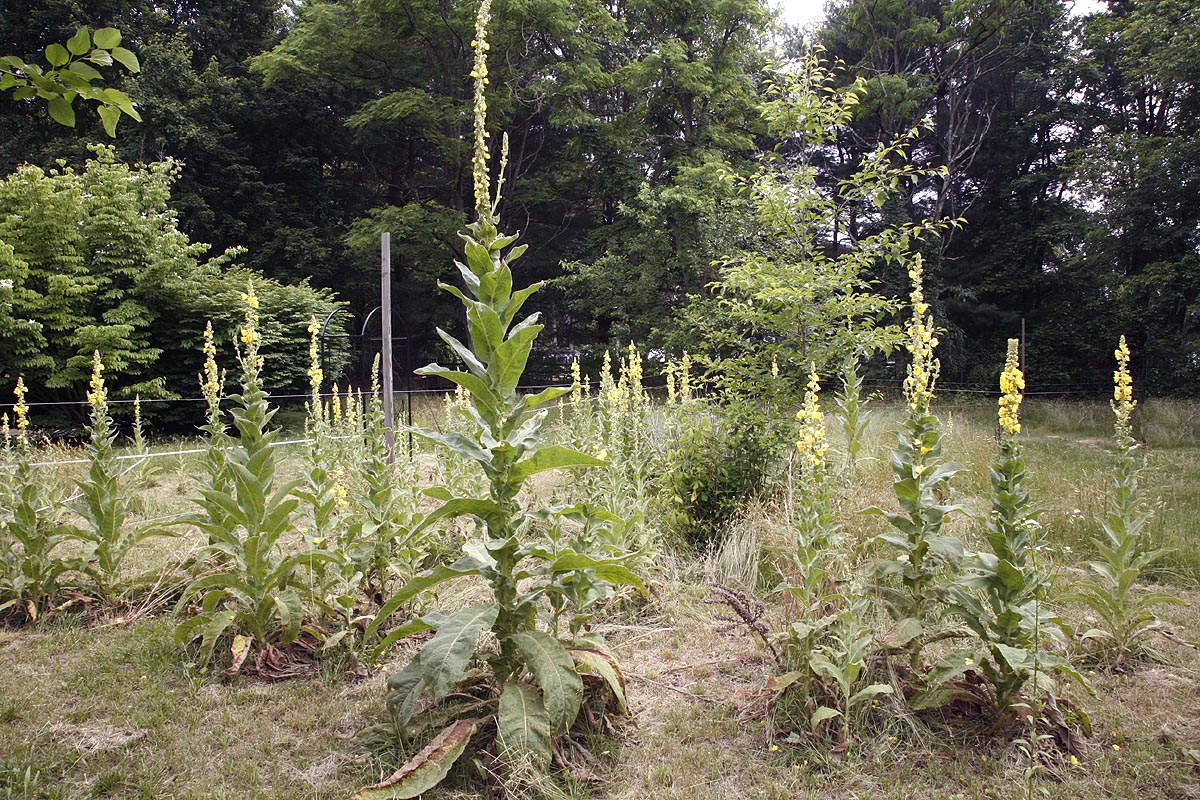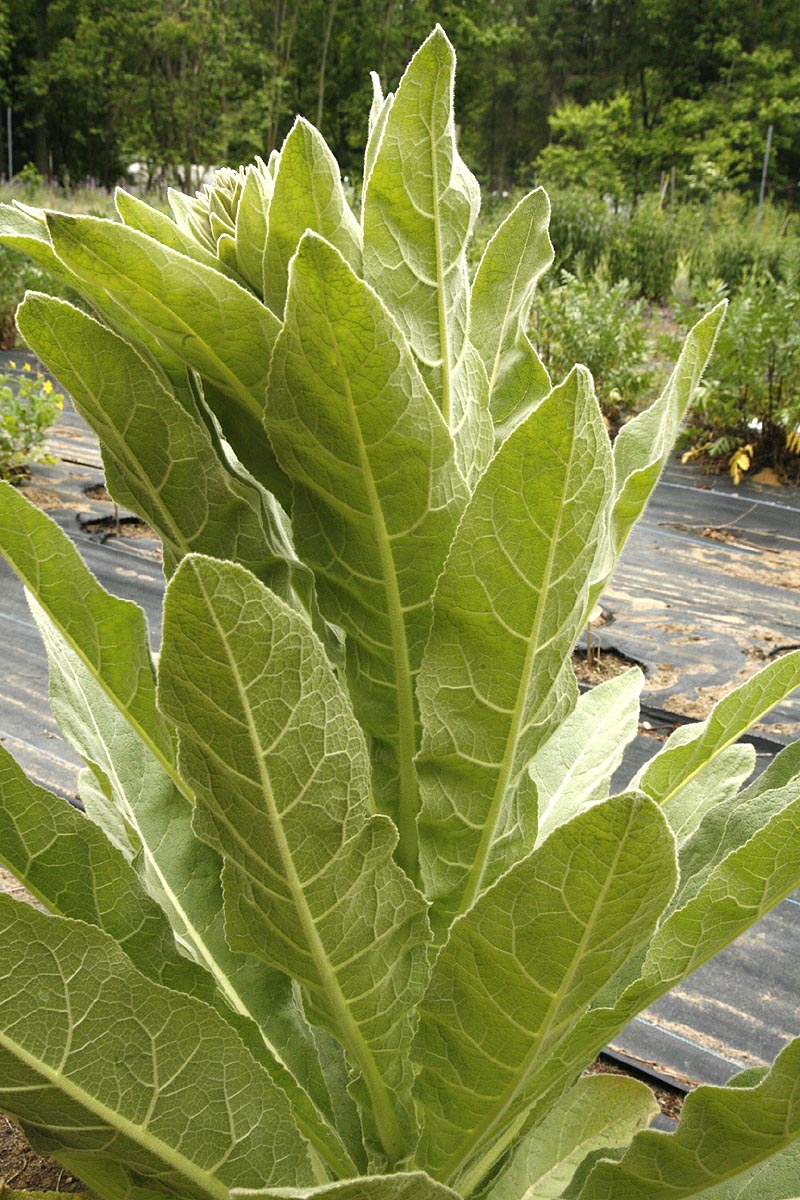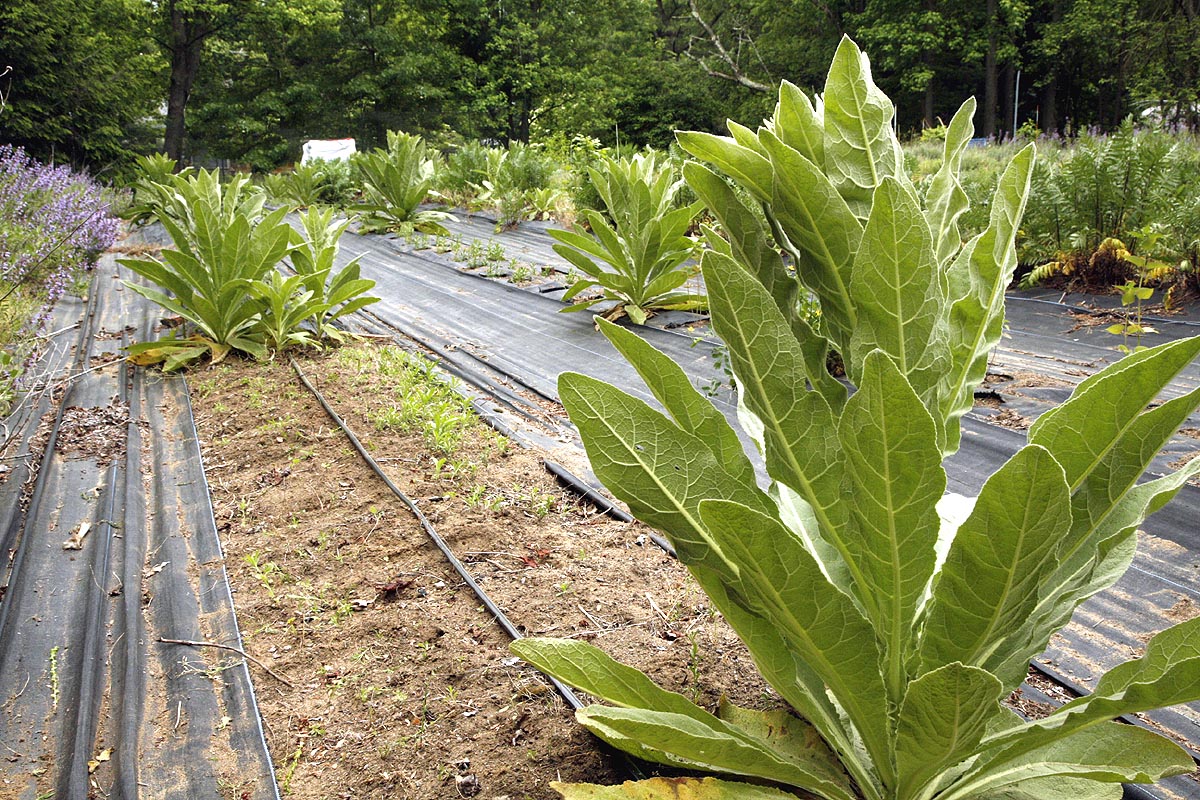Description of Great Mullein (Verbascum thapsus).
The following spring the plant puts up a single thick solitary pale stem which can grow up to 8 feet (2.4 m)in height. It is usually unbranched but occasionally one or two side branches will occur. The stems are also covered with the downy white hairs. The leaves are simple stem less oblong tapering to a point with smooth or slightly crenulated margins gray green and covered with downy white hairs. The leaves are larger at the base up to 12 inches (31 cm) long and 4 inches (10 cm)across becoming smaller as the ascend the stem. The are positioned on alternate sides of the stem . The leaves are simple and arranged so that the smaller upper leaves direct any water down to the larger leaves below and hence to the ground. This allows the mullein to collect more rainwater on the very dry soils it tends to inhabit.
The tall stem is topped with a flower spike usually about a foot in length which is packed with small sulphur yellow 5 petaled flowers about an inch across. The flowers open a few at time at random over the flower spike not in a progression from top to bottom as in most flowers. Thus the flower spike always has some blooms on it during the flowering period which can last from 6 - 8 weeks from early summer onwards. The flowers are followed by small seed capsules each with two cells containing numerous seeds. The spike is very dense and will remain standing throughout the winter even under some very harsh conditions. It is a native to Europe.
Growing Great Mullein (Verbascum thapsus) from seed.
Seeds are small so sow following our small seed sowing directions, then pot on into larger pots as the plants grow. Seeds need light to germinate so don't cover them. Keep the soil moist until seedlings appear. Transplant into individual pots as soon as they plants are large enough to handle. Mulleins develop tap roots so pick the tallest pots you can to pot into. Grow on until plants are large enough and danger for frost has passed before setting outside. Dig large holes and ensure that the root is not disturbed when transplanted. If the roots have began to protrude from the base of the pot cut the pot off the plant do not force the roots apart or the plant may not survive.
Water well when transplanting and every other day thereafter - if no rain - for at least three weeks if the plants look happy and beginning to establish themselves watering can be stopped at this point, only continue to water until the plants are putting out new leaves and look established. Plants should need no extra water even in drought.
Location and care of Great Mullein (Verbascum thapsus).
Mullein needs a well drain soil and cannot tolerate heavy clay or waterlogged soils. The flower spikes are tough and can tolerate fairly strong winds but it does not like salt air or sea winds so it is not suited to seaside gardens. It is very drought tolerant and needs no additional water once established. It is ideal for stony, sandy areas where little else grows well. Hardy to zone 3.
Mullein is ideal for back borders, cottage gardens and as focus plants. They can be grown individually or in groups. If planting in a cottage garden or border be aware that the leaf base gets very large and will smother anything else around it so give the plants plenty of space. Space at least for 3 feet (1 m) apart. If for a back border ensure that they have sufficient light in the first year when the rosette is only at ground level if they are overshadowed or shaded by other plants they will not survive.
If growing in an old lawn or meadow location care should be taken when mowing not to cut down the first year plants. Mulleins will self seed but they never seem to seed where you want them too. Learn to identify the new plants and either mow around them or dig them up and move them to the desired location.
Harvesting Great Mullein (Verbascum thapsus).
Leaves. can be collected from the first year plants and during the second year in the early spring before the plant flowers. Any preparation using the leaves should be carefully filtered to remove the fine hairs which can be very irritating to both the skin and throat.
Roots. Roots should be dug up at the end of the first year, wash and dried either sliced or whole.
Both leaves and flowers can be placed on racks to dry or use a dehydrator.
Note. The leaves can be an irritant. If rubbed against the skin it can cause redness and irritation (its due to the hairs). So take care not to choose these large fluffy leaves and substitute towels or 'body part' wipes.
Medicinal Uses of Great Mullein (Verbascum thapsus).
Note. Any preparation made from the leaves needs to be carefully strained in order to remove the small hairs which can be an irritant to both the skin and the throat. This can be extremely unpleasant and needs to be avoided.
An infusion of the flowers in olive oil is strongly antibacterial and is used as earache drops, or as a local application in the treatment of piles and other mucous membrane inflammations.
The roots are used to make a decoction that helps to reduce toothache, as well as relieve cramps and convulsions. Powdered the roots are used as a rough wart remover although it appears to have no effect on smooth warts.
Seed. There is contention over the use of seeds. Many state that the seeds are poisonous and should be avoided at all costs others state that a decoction of them can be used to soothe chilblains and chapped skin.
Other Uses of Great Mullein (Verbascum thapsus).
The leaves of mullein and the dry stalks are considered as some of the best fire starting tinder available. Leaves are often carried in survival kits for this purpose. Carefully twisted they were once used as candle wicks. The dried flower stalks have been used as torches for centuries, dipped in tallow and set alight they will burn for long periods of time. The leaves also contain rotenone which is used as an insecticide.
Toilet paper: while some have stated that Mullein leaves can be used as substitute toilet paper since they are so large and soft care should be taken as the hairs tend to break off and can be very irritating. Try it on your arm or leg to see if you have a reaction before you subject more tender parts of your anatomy.
Other names






